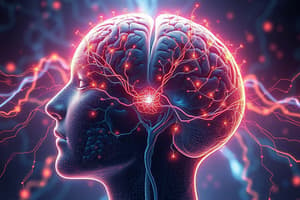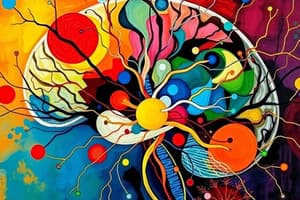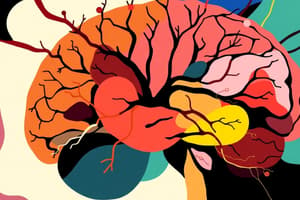Podcast
Questions and Answers
What are the two main branches of the nervous system?
What are the two main branches of the nervous system?
- Somatic and Autonomic
- Central and Peripheral (correct)
- Sensory and Motor
- Sympathetic and Parasympathetic
The endocrine system works much faster than the nervous system.
The endocrine system works much faster than the nervous system.
False (B)
Which of the following is NOT a part of the somatic nervous system?
Which of the following is NOT a part of the somatic nervous system?
- Skin
- Bones
- Internal organs (correct)
- Skeletal muscles
The autonomic nervous system is under our conscious control.
The autonomic nervous system is under our conscious control.
Which part of the nervous system is responsible for the 'fight-or-flight' response?
Which part of the nervous system is responsible for the 'fight-or-flight' response?
Which of the following is NOT a function of the parasympathetic nervous system?
Which of the following is NOT a function of the parasympathetic nervous system?
What are the three main types of neurons?
What are the three main types of neurons?
What is the functional unit of the nervous system?
What is the functional unit of the nervous system?
Which part of a neuron receives information from other neurons?
Which part of a neuron receives information from other neurons?
The myelin sheath slows down the transmission of nerve impulses.
The myelin sheath slows down the transmission of nerve impulses.
What causes the resting membrane potential of a neuron?
What causes the resting membrane potential of a neuron?
Depolarization is the process of the neuron becoming more positive inside.
Depolarization is the process of the neuron becoming more positive inside.
What is the term used to describe the minimum level of stimulation required for a neuron to fire?
What is the term used to describe the minimum level of stimulation required for a neuron to fire?
The strength of a stimulus affects the intensity of a nerve impulse.
The strength of a stimulus affects the intensity of a nerve impulse.
What does the brain use to interpret the intensity of a stimulus?
What does the brain use to interpret the intensity of a stimulus?
What is the name of the small space between neurons where neurotransmitters are released?
What is the name of the small space between neurons where neurotransmitters are released?
Neurotransmitters are always excitatory.
Neurotransmitters are always excitatory.
Which of the following is a common neurotransmitter that opens sodium channels?
Which of the following is a common neurotransmitter that opens sodium channels?
What does the term 'botulism' refer to?
What does the term 'botulism' refer to?
Botulism toxin can be used for therapeutic purposes.
Botulism toxin can be used for therapeutic purposes.
What is the purpose of a reflex arc?
What is the purpose of a reflex arc?
What are the five components of a reflex arc?
What are the five components of a reflex arc?
Reflex arcs only involve signals going to the brain.
Reflex arcs only involve signals going to the brain.
Flashcards
Synapse
Synapse
The space between neurons where communication occurs.
Synaptic Transmission
Synaptic Transmission
The process of transmitting information across a synapse.
Neurotransmitter
Neurotransmitter
A chemical messenger released from a neuron that travels across the synapse to influence another neuron.
Acetylcholine
Acetylcholine
Signup and view all the flashcards
Serotonin
Serotonin
Signup and view all the flashcards
Dopamine
Dopamine
Signup and view all the flashcards
GABA
GABA
Signup and view all the flashcards
Exocytosis
Exocytosis
Signup and view all the flashcards
Endocytosis
Endocytosis
Signup and view all the flashcards
Presynaptic Neuron
Presynaptic Neuron
Signup and view all the flashcards
Postsynaptic Neuron
Postsynaptic Neuron
Signup and view all the flashcards
Neurotransmitter Receptor
Neurotransmitter Receptor
Signup and view all the flashcards
Reuptake
Reuptake
Signup and view all the flashcards
Antagonist
Antagonist
Signup and view all the flashcards
Agonist
Agonist
Signup and view all the flashcards
Action Potential
Action Potential
Signup and view all the flashcards
Threshold
Threshold
Signup and view all the flashcards
Refractory Period
Refractory Period
Signup and view all the flashcards
All-or-None Principle
All-or-None Principle
Signup and view all the flashcards
Neural Communication
Neural Communication
Signup and view all the flashcards
Study Notes
The Nervous System
- The nervous system is a complex communication system, containing over 100 billion nerve cells (neurons) in the brain alone.
- It's divided into two main parts:
- Central Nervous System (CNS): Composed of the brain and spinal cord. It coordinates incoming and outgoing information.
- Peripheral Nervous System (PNS): Consists of nerves carrying information between the body and the CNS.
Endocrine vs. Nervous Control
- Prolonged Response (Endocrine): Hormone release in response to imbalances takes time. Hormones travel through the bloodstream to target cells, causing a prolonged response.
- Speed (Nervous): The nervous system responds rapidly (seconds or fractions of seconds) to quick changes in the environment.
PNS: The Somatic System
- The somatic nervous system controls voluntary actions.
- This system controls skeletal muscles, bones, and skin. It relays information about the external environment to the brain.
- We have conscious control over this system. We can sense environmental changes like heat, light, touch, taste, and smell and respond accordingly.
PNS: The Autonomic System
- The autonomic nervous system controls involuntary actions. This system handles the internal organs (e.g., stomach churning, digestion).
- It's not under conscious control.
- It's balanced by the sympathetic and parasympathetic systems like an on/off switch.
PNS: Autonomic - Sympathetic vs. Parasympathetic
- Sympathetic: Dominates during stress, danger, excitement, or strenuous activity. It increases the heart rate and blood pressure.
- Parasympathetic: Dominates during quiet or low-stress situations. It reduces sympathetic responses, promoting functions like digestion.
The Nerve Cell
- Neurons are the functional units of the nervous system.
- Three types of neurons:
- Sensory (afferent): Detect and relay information from the environment to the CNS. Located in ganglia outside the spinal cord.
- Interneurons (association neurons): Connect other neurons, primarily within the brain and spinal cord.
- Motor (efferent): Relay information from the brain to muscles, organs, and glands to respond to stimuli.
Neuron Structure
- Dendrites: Receive information from other nerve cells.
- Cell body: Contains organelles and carries out metabolic processes.
- Axon: Carries signals away from the cell body to other neurons, muscles, or glands.
- Myelin sheath: Insulating layer on some axons, increasing transmission speed.
- Nodes of Ranvier: Gaps in the myelin sheath that speed up signal transmission.
Electrochemical Impulse
- Resting potential: The membrane maintains a charge difference (-70 mV) when not sending signals.
- Action potential: When a neuron is excited, the membrane potential briefly reverses (+40 mV) creating a fast-moving excitation. Sodium and potassium ions contribute to this electrochemical process.
Neuron Excitation and the Threshold Level
- Sensory neurons respond to environmental change (stimuli).
- The stimulus’s intensity must reach a threshold level, causing the depolarization of the membrane in order for the nerve signal to be sent.
- A stronger stimulus does not cause a stronger response; instead the response is sent by the same speed and intensity.
Signal Intensity
- The brain interprets signal intensity based on the frequency of impulses (how often signals are sent).
- More intense stimuli trigger signals more rapidly.
The Synapse
- The space between neurons.
- Information passes from one neuron to another through neurotransmitters released by the presynaptic neuron..
- Neurotransmitters bind to receptors on the postsynaptic neuron, initiating the next signal.
Synaptic Transmission
- Chemical neurotransmitters travel across the synaptic cleft, initiating a response by binding to postsynaptic neuron receptors.
- The speed of transmission is influenced by the number of synapses involved, with multiple synapses resulting in slower transmission.
Neurotransmitters
- Acetylcholine is a common neurotransmitter that opens sodium ion channels in the postsynaptic neuron, transmitting signals.
- After transmission, the enzyme cholinesterase breaks down acetylcholine.
Botulism
- Botulism toxin interferes with the release of acetylcholine. This paralysis the muscles and stops them from contracting.
- The effects of botulism toxin can be enduring (permanent).
Reflex Arc
- Used for quick responses to threatening stimuli.
- Consists of:
- Receptor that detects environmental change
- Sensory neuron relays signal to the spinal cord.
- Interneuron in the spinal cord integrates the information.
- Motor neuron relays the signal to activate an effector (muscle, gland) to make a change.
Studying That Suits You
Use AI to generate personalized quizzes and flashcards to suit your learning preferences.




